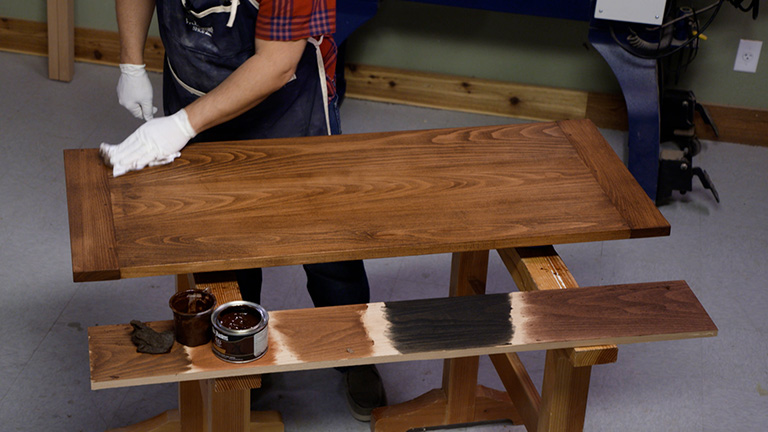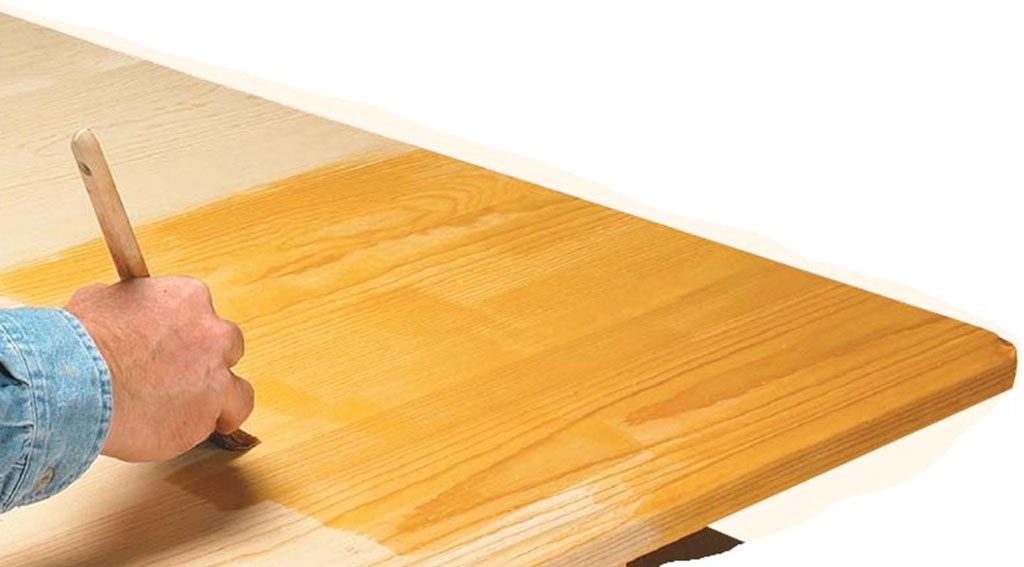
Woodworkers are pretty lucky these days. When it comes to deciding what type of finish to apply to a project, we have an abundance of options. The catch is that each class of finish has its own specific, and often very different, attributes. So choosing the best finish for a particular project involves matching up your requirements with the right finish. The key is having a good understanding of what each type of finish has to offer.

Wipe-on oil finishes can't be beat for fool-proof application and rich color. However, don't count on a high degree of protection.
CRITERIA. I judge each type of finish based on three basic criteria. First, I consider what sort of appearance the finish will produce — specifically, color and sheen. Next, you need to take into account the method and ease of application. Finally, you want to match the protection and durability offered to the needs of the project. I’ll offer a brief summary of how the common finishes available to woodworkers stack up in each of these areas.
PURE OIL.
Simply wiping on several coats of a pure oil such as linseed or tung oil rates very high in terms of foolproof application. And the amber color that the oil imparts can be very desirable on many woods. However, on the downside, a pure oil finish won’t build a protective film, regardless of the number of coats you apply. You’ll get very limited moisture and abrasion resistance and little sheen. It’s best saved for “lightduty” projects that won’t see a lot of wear and tear.
OIL/VARNISH BLEND. A similar type of finish is referred to in the trade as an oil/varnish blend. It’s simply a mixture of a pure oil, varnish, and mineral spirits. Watco and Minwax are a couple familiar brands. It’s equally easy to apply and produces an appearance similar to a pure oil. The bonus is that the varnish in the blend will give you slightly better protection. It will only build to a thin, relatively soft film with a moderate sheen. So again, don’t press your luck. Limit use to projects that will be treated kindly.
WIPING VARNISH. A wiping varnish is merely a varnish that’s been thinned about 1 to 1 with mineral spirits. The advantage is that the mixture is fluid enough to be applied easily with a rag. However, since a wiping varnish dries faster than an oil, you have to work at a good clip to wipe on the finish and then wipe off the excess before it tacks up. A wiping varnish adds a fair amount of amber color to the wood and will build a thin film with a noticeable sheen. I would rate the protection offered by wiping varnish as moderate. It’s a relatively foolproof choice for many moderate wear projects.

A good-quality spray system makes fast-drying lacquer or water-based finish a good option.
SHELLAC. Pre-mixed shellac consists of a natural resin dissolved in alcohol. It’s extremely fast drying time makes it a very appealing finish. You can brush, spray, or wipe on a coat and it will be dry in a matter of minutes — ready to sand and re-coat. This is why shellac makes a very useful sealer that can be applied under almost any other finish.
Available in both clear and amber, it produces a warm color and builds to a high sheen. Its moisture and scratch resistance fall in the low to middle range. I recommend shellac for any classic project that won’t see much wear.
LACQUER. Lacquer consists of synthetic resins dissolved in very powerful solvents. Due to its fast drying time, lacquer is most easily applied with spray equipment. And for this reason, it’s the standard finish on most commercially produced furniture. (There are slower-drying types that can be brushed.) You’ll find that all lacquers have a strong odor.

Polyurethane varnish forms a film that offers a very high degree of moisture and abrasion resistance.
Standard lacquers produce a film with just a hint of amber color and a pleasing sheen. You have your choice in a range from matte to high gloss. You’ll get fairly reliable moisture protection and good overall durability. If you have the means to apply it successfully, lacquer is a great way to finish any project.
WATER-BASED FINISH. Water-based finish is the new kid on the block. It’s formulated using many of the same resins contained in other finishes, but with water as the carrier. So the big selling point is the absence of odor-producing and potentially harmful solvents. It can be sprayed, brushed or padded on, although successfully brushing a water-based finish requires a practiced technique. The fast drying time is a big plus while a tendency to raise the grain is a drawback.
One common knock on waterbased finish is the lifeless, waterclear film it produces. The look can be pretty bland. An initial stain or sealer is often necessary to add color to some woods.
From my experience, waterbased finishes hold up well to all kinds of use and abuse. I wouldn’t be afraid to apply one to just about any type of project.
VARNISH. If durability and allaround protection are at the top of your wish list, varnish should be your choice. Although it comes in several formulations or resin types, polyurethane varnish now dominates the market. It forms a tough film that’s heat, moisture, and scratch resistant. The light amber color of a poly varnish adds a warm look to the wood. However, a thick “poly” varnish can take on a plastic look.
Varnishes are most commonly applied with a brush. But be aware that it takes an experienced hand to do a good job. The slow drying time is a negative. Only one coat a day is the rule. And you’ll need to control dust in the air. A poly varnish is my number one choice for a “high-traffic” project such as a kitchen or coffee table.
Choosing the perfect finish for a project often comes down to striking the right balance. The good news is that when you decide what you want from a finish, there’s sure to be a choice that will meet your requirements.













